Whanganui River Journey
Over New Year we spent 5 days in a red canadian canoe (all starting singing – we all live in a red canadian canoe – to the tune of yellow submarine – we did for the majority of the 5 days on the river!) as we paddled down the Whanganui River on one of New Zealands “Great Walks” – yes I know this isn’t walking but hey ho! The Journey is 145 km long and has over 200 named rapids…
We awoke to quite a lot of rain in the morning, and it didn’t look like good paddling weather but by the time we’d sorted everything out it had cleared and we had good weather all day – yippee!
At 9.30 am with our gear (including a bottle of fizzy pop for New Year) loaded into three 50 litre barrells off we set.
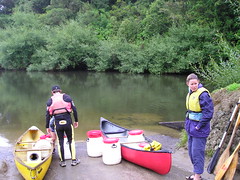
The first day saw us going through quite a few rapids (Cherry Grove – Poukaria – c. 35.5km). The first one being about 1 minute after being put into the river! We had been given a briefing by the bloke we’d hired the canoes from and so knew to head for the middle of the V and off we went. Bounce, bounce, bounce over the pressure waves and out the other side – no worries (or ‘sweet’ if we talk Kiwi!)
That was basically the gist of the first day – we had been told that the best way to get through the rapids was to keep paddling, about 10 minutes into the journey, and one of the bounciest rapids we went through I decided to hold on to the canoe rather than paddle and I got a big yell from Nick behind me “paddle” – little did he know how bouncey (and wet) it gets in the front of the canoe – it is much smoother at the back (he got to find out on the second morning and I was forgiven, but my skills at steering left a little to be desired, so I was at the front and Nick was at the back for the majority of the time).
The river was fairly wide for most of the journey down – the gorge section was to come later – and as we got more confident through the rapids our speed picked up. We stopped for a coffee and cake (very yummy and most welcome) at at lavendar farm about half way through the day – the canoe was tied up and we walked up through native tree ferns and bush for about 5 minutes – the suddenly the bush disappears and you are left with rows of lavendar – quite bizzare!
We past the first campsite (Ohiepane) and decided to go down the rapid rather than use the ‘chicken chute’ on the left hand side. This had the largest pressure waves we’d seen and I certainly got bounced around (a chap at the campsite was standing at the side watching us too – no pressure! I remembered to keep paddling even if I thought I was going to get thrown out – got very wet and throughly enjoyed it! This could have thrown us out it we hadn’t been careful, but we were saved from a full drenching (and embrassement!
So we continued down to the next campsite at Poukaria – there was a a group already there, but we were expecting to encounter people – we were in the busy period afer all…as it turned out it was only us and the other group who camped there that evening. The campsite was set up from the river on grassy banks and we spent remainder of the afternoon watching the river flow by (fairly fast!) it is amazing how time flys!
Day two (New Year’s eve) saw us heading for Managapapa campsite (c. 32.5km) and it basically very much the same as the day before, but as we paddled down we saw the river narrow and the banks steepen and into the gorge section we went. The banks were basically vertical with tree ferns and trees clinging to the sides with very little earth for their roots. We had to look out for ‘snags’ the whole time – where the earth had given way and the trees etc had slipped into the river (the term also encompasses hidden rocks).
We didn’t see any other groups (apart from the group we’d camped with the night before) as we passed Whakahoro (a popular place to ‘put in’ if doing the 3-day journey) and we wondered how busy the campsite would be.
Mangapapa campsite took some manovering to get us and our barrels out – the water level was very low and it was quite tricky getting out on the steep mud banks. This campsite was set higher that the night before (and in the end was my favourite) and we were the only people there on arrival. So we picked our camp spot, set up the tent and sat in the sun – watching the clouds get greyer.
We’d been listening to thunder rumble over the river for a while, when suddenly there was a lightening flash streak over our heads – we didn’t even have time to think ‘that was close’ when the thunder cracked over head and we both jumped a foot in the air! Fairly scary…then the rain came.
In the end it only rained for about an hour or so and we were able to sit back outside by the river again.
So much for the busy season though, by 7.30pm no one else had arrived (or past by) so it looked like we were to be on our own for NYE. We had the bottle of fizzy pop ‘cooling’ in the river (we think it was actually being warmed!) but as the weather wasn’t great and we were both tired we decided to save it for a sunny evening. In the end we were in bed by 9pm – so much for new year celebrations!
Day three was our longest day to Mangawaiiti campsite (c.37.5km) and our earliest start – on the river by 8.30am – we’d decided not to stay at John Coull hut (which was going to be a lunch stop instead) as it has a reputation for getting very busy so picked the next campsite down (which was described as the prettiest campsite on the river). Not so many rapids on this section – and a 6km section of basically straight – luckily the rain had raised the river slightly so that helped us along and the wind wasn’t blowing towards us on the straight section and we made good time to the hut. We were greeted by the warden at the hut and his wife. They kindly put the kettle on for us and made us a cup of tea. We had an interesting chat with them – he had been associated with the river for most of his life (they were both certainly in their 60’s at least) – there had been about 23 tents and a full hut a couple of days previously (c. 70-80 people) so were glad at our decision to push on!
Mangawaiiti campsite was high up in the gorge – a good 2-3 minute walk up steep sides with barrels! It wasn’t as nice as I’d expected as it was surrounded by bush and so you didn’t get good views of the river which was disappointing.
We made a make shift fridge (wet towel around fizzy pop bottle standing in water), which worked really well at cooling the fizzy pop down and celebrated New Year (fizzy pop in plastic mugs works well)!
We were joined by a group of kayakers here and it was nice to have company – we had a good fire going and chatted for a fair while into the evening.
Day four – a short-ish day of paddling (Mangawhaiiti to Ramanui c. 20km) – but included a side (c.40 min) walk to the “Bridge to Nowhere” (all sing “we’re on the river to nowhere…”) – the bridge was built in the 1930’s to provide access to developing farms in the Mangapurua Valley it was known as the Mangapurua Valley Soldiers Settlement. Today the bridge is virtually the only surviving sign that any settlement ever existed. By the time it was completed these areas of the Mangapurua Valley were deserted, the bridge rarely used and the construction of the road to the Whanganui River abandoned. It was a strange sight nestled in the bush.
We were paddling into a strong head wind for most of the day which was really hard work – the wind tended to catch the canoe and we’d head off in the opposite direction to which we were trying to paddle! We found the best option was to pick a side of the gorge and try and ‘creep’ up the side – easier said than done – lots of trees and snags to the sides…! The gorge section also pettered out and the river widened again – the excess water from the rain on New Year’s Eve had drained away and it felt as if you were paddling in syrup at times and not going anywhere.
Ramanui campsite was a strange place – it had a feeling of being abandoned and in need of some TLC – especially as there were a group of 5 or 6 young bulls hanging out and pooing in the shelters. It was a nice evening and the time drifted away – we thought we’d be the only people at the campsite again, but a couple turned up at about 7pm ish and we had company!
The river is a wonderful place to forget about life as you slowly paddle down. It is a very peaceful way of travelling – listening to the birds (mainly tui’s) and spotting the odd feral goat hanging out by the river banks.
Day five and the end of our journey – another early start as we had to get to the end Pipiriki by 1.30pm and had c. 21.5 km of paddling to get through!
The head wind was even stronger than the day before and the last day was really hard work through syrupy water which seemed to flow backwards at times – very few rapids to speed us on our way – apart from right at the end where we encountered the most exciting ones on the whole journey – REALLY big pressure waves and I nearly got bounced out (the yell of “paddle” from the back soon turned into “lean, hold on!”).
We arrived at Pipiriki wet but happy – the last couple of rapids had made up for the hard battle in the wind.
Tags: Great Walk, New Zealand, Travel, Trek

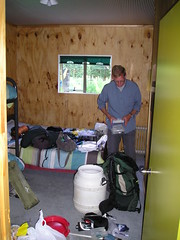
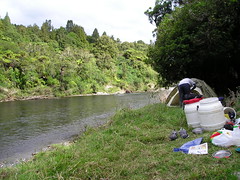
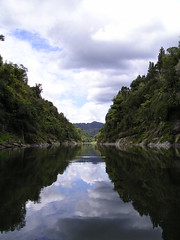
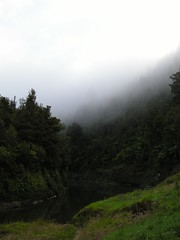

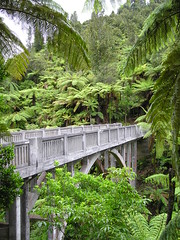
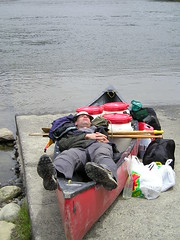
Leave a Reply